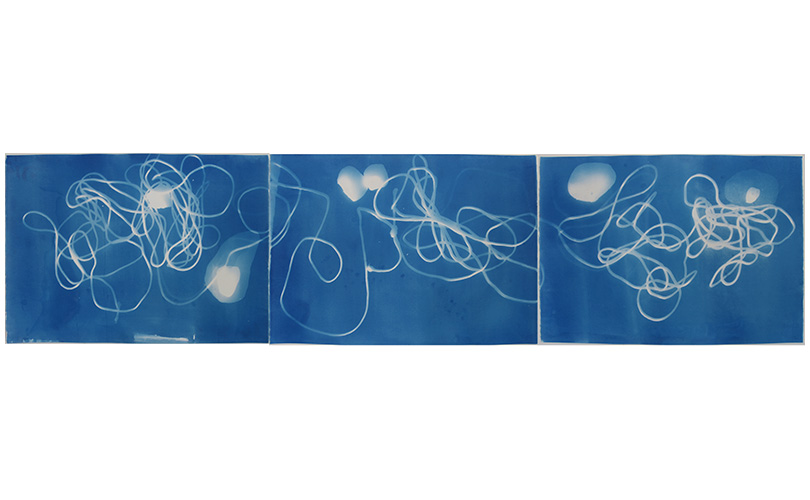Seeing the Unseen: 100-Foot Rope
I dash out to the banks of the river ... and find myself amongst the rushes and the reeds. I grind some pigment over all this and the wind makes their slender stalks bend and appliques them with precision and delicacy on to my canvas, which I thus offer to quivering nature: I obtain a vegetal mark. Then it starts to rain; a fine spring rain: I expose my canvas to the rain ... and I have the mark of the rain! — a mark of an atmospheric event. - Yves Klein 1960
Madison moves from the crowded digital image maze to make works that capture the essence of wind, water and sunlight. Using the cyanotype photographic printing process that produces a cyan-blue print Madison makes a photogram of an ordinary 100-Foot rope that can be found in any hardware store. She takes the rope to the site of a natural body of water where the print will be developed. The 100-Foot rope stretches across several sheets of paper, as it is exposed to the temporal sunlight, creating the impression and shadows of the rope on the paper, and then developed in the river or ocean. The wind affects both the exposure and development process by moving the rope and the paper becoming a part of the artwork.
Madison has used the 100-Foot rope in earlier photographs, thinking about landscape and ownership drew her to” the foot” as a unit of measurement and she says “ I like the history of using the body as a method of measurement and the way it ties the body and the land together. “
Colin Westerbeck talks about her work in THE HERE AND NOW, FROM A to Z in Artillery magazine, “She quotes Jean-Jacques Rousseau on how “the fruits of the earth belong to us all, and the earth itself to nobody.” Her photographs are a conceptualist piece determined by the way a 100-foot rope extended into the landscape. She challenges the overdevelopment going on in the fragile ecosystem of the desert. “
Madison takes inspiration and challenge from the work of Yves Klein, and with this work the concept of what is “invisible” is endless. The rope has left a mark on the paper but you cannot see the rope, the rope itself spanning three sheets of paper, or squeezed onto a single sheet, refers to the “invisible” concept of land ownership, the sea that is owned by no one, developed the image and is imbedded inside the paper but is not visible. Alternately, the prints can be appreciated for their formal abstraction and the brilliant blue color of the cyanotype process





